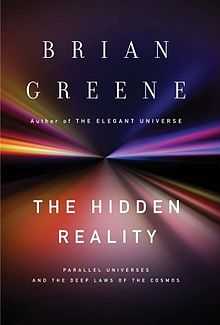The Hidden Reality
 | |
| Author | Brian Greene |
|---|---|
| Subject | Multiverse |
| Genre | Non-fiction |
| Publisher | Alfred A. Knopf |
Publication date | January 25, 2011 |
| Media type | Print (Hardcover and Paperback), also Audiobook |
| Pages | 384 |
| ISBN | 0-307-26563-3 |
| Preceded by | Icarus at the Edge of Time |
The Hidden Reality is a book by Brian Greene published in 2011 which explores the concept of the multiverse and the possibility of parallel universes. It has been nominated for the Royal Society Winton Prize for Science Books for 2012.
Content
In his book, Greene discussed nine types of parallel universes:
- The quilted multiverse only works in an infinite universe. With an infinite amount of space, every possible event will occur an infinite number of times. However, the speed of light prevents people from being aware of these other identical areas.
- The inflationary multiverse is composed of various pockets where inflaton fields collapse and form new universes.
- The brane multiverse follows from M-theory and states that each universe is a three-dimensional brane that exists with many others. Particles are bound to their respective branes except for gravity.
- The cyclic multiverse has multiple branes (each a universe) that collided, causing Big Bangs. The universes bounce back and pass through time, until they are pulled back together and collide again, destroying the old contents and creating them anew.
- The landscape multiverse relies on string theory's Calabi-Yau shapes. Quantum fluctuations drop the shapes to a lower energy level, creating a pocket with a different set of laws from the surrounding space.
- The quantum multiverse creates a new universe when a diversion in events occurs, as in the many-worlds interpretation of quantum mechanics.
- The holographic multiverse is derived from the theory that the surface area of a space can simulate the volume of the region.
- The simulated multiverse exists on complex computer systems that simulate entire universes.
- The ultimate multiverse contains every mathematically possible universe under different laws of physics.
Reception
Timothy Ferris reports in the review in The New York Times Book Review that “If extraterrestrials landed tomorrow and demanded to know what the human mind is capable of accomplishing, we could do worse than to hand them a copy of this book.” [1]
Anthony Doerr, in his On Science column of the Boston Globe, wrote that "Greene might be the best intermediary I’ve found between the sparkling, absolute zero world of mathematics and the warm, clumsy world of human language." Doerr praised Greene's use of analogies to explain the complex phenomena of parallel universes.[2]
John Gribbin, in the Wall Street Journal, declared that The Hidden Reality was "Mr. Greene's weakest book", but conceded that Greene's earlier books "left him with such high standards to live up to that this is not really surprising." Gribbin also criticized the lack of depth on certain subjects, such as M-theory and the interactions of three-dimensional universes.[3]
Publishers Weekly hails The Hidden Reality “An in-depth yet marvelously accessible look inside the perplexing world of modern theoretical physics and cosmology . . . Greene presents a lucid, intriguing, and triumphantly understandable state-of-the-art look at the universe.”(Starred review)
Janet Maslin, The New York Times claims “Mr. Greene has a gift for elucidating big ideas . . . Exciting and rewarding . . . [The Hidden Reality] captures and engages the imagination.”[4]
John Horgan. Scientific American "Is speculation in multiverses as immoral as speculation in subprime mortgages?." "Horgan’s exasperation with seeing the multiverse heavily promoted by famous physicists appears to have more to do with the idea that this is a retreat by physicists from engagement with the real world, something morally obtuse in an era of growing problems that scientists could help address." [5]
Lee Smolin "... discussions of a multiverse containing infinite numbers of copies of ourselves behaving slightly differently made him uneasy for moral reasons. The worry is that one might be led to stop caring that much about the implications of one’s actions. After all, whatever mistake you make, in some other infinite number of universes, you didn’t do it." [5]
Peter Woit "My own moral concerns about the multiverse have more to do with worry that pseudo-science is being heavily promoted to the public, leading to the danger that it will ultimately take over from science, first in the field of fundamental physics, then perhaps spreading to others. [5]
Popular culture
The book and its author were featured on the television series The Big Bang Theory in episode 20 of season 4, "The Herb Garden Germination".[6]
See also
Related books
- Brian Greene, The Fabric of the Cosmos
- Lisa Randall, Warped Passages
- Michio Kaku, Parallel Worlds (book) (2004)
- Leonard Susskind, The Cosmic Landscape (2005)
- Alexander Vilenkin, Many Worlds in One: The Search for Other Universes (July 2006)
- Sean Carroll, From Eternity to Here
- John Gribbin, In Search of the Multiverse
- Stephen Hawking and Leonard Mlodinow, The Grand Design (book)
- Steven Manly, Visions of the Multiverse
Footnotes
- ↑ Ferris, Timothy (4 February 2011). "Expanding Horizons". The New York Times Sunday Book Review. Retrieved 21 September 2011.
- ↑ Doerr, Anthony; On Science (23 January 2011). "Chasing Pythagoras and parallel universes". The Boston Globe. Retrieved 21 September 2011.
- ↑ Gribbin, John (26 January 2011). "Welcome to the Multiverse: Our universe may be just one among an infinite number—some supporting life, others sterile". Wall Street Journal. Retrieved 21 September 2011.
- ↑ Maslin, Janet (26 January 2011). "Multiple-Universe Theory Made, Well, Easier". The New York Times. Retrieved 21 September 2011.
- ↑ 5.0 5.1 5.2 "Is the Multiverse Immoral?".
- ↑ Amazon: The Hidden Reality: Parallel Universes and the Deep Laws of the Cosmos
| ||||||||||||||